Once upon a time, the 4NCL was all about teams full of expensively hired Grandmasters battling it out for the top prize. You had to have a FIDE rating well over 2000 or equivalent to even think about getting a game. And, of course, in the first and, to an extent, the second division this is still very much the case. But since the introduction of the third and fourth divisions, 4NCL has been opened up to the masses.
Don’t get me wrong – there are still some very strong performers including several titled players in the lower two divisions, and some tremendous chess is played there. It does, however, give the opportunity for the average club player such as Woody to enjoy the unique experience of playing 4NCL chess. In fact it’s probably fair to say that anyone with sufficient enthusiasm to seek out a team and find their way to West Bromwich for a few weekends each year can get a game in our still prestigious national league. It can only be good for encouraging wider participation in the game that this is the case.
For those who don’t know that much about the 4NCL, it takes place over five weekends each year, which this season spanned from late November 2003 to mid June 2004. With one of the weekends being a Bank Holiday weekend, and one match each day, this means a total of 11 matches in the season. Unfortunately, this season, due to a lack of capacity at the available hotels, the third and fourth divisions have taken place on separate weekends to the first and second divisions. This is a shame, since it deprives the lesser players of the chance to see some of the top GMs in action, though as I said before, there is still plenty of quality chess to be seen. And sadly these split weekends will continue next season, though I believe the organisers are doing their best to find a large enough venue to house all four divisions in the future. This season the third and fourth divisions have taken place at the West Bromwich Moat House, a pleasant venue and central to the country – essential when you have teams competing from locations as diverse as London, Pontypridd and Cambridge. In the top three divisions, teams are made up of 8 players, at least one of whom must be of each sex, while teams in the fourth division are 6 players strong. And with three divisions of 12 teams and one of 16, that makes a mind-boggling total of 384 chess players participating in each round of matches and an extraordinary 2112 games taking place during a 4NCL season. That’s a lot of chess.
One of the best things about the 4NCL from a club player’s perspective is the fact that we get to play a diverse selection of players from all over the country. This can make a refreshing change from playing the same relatively small selection of players in the local league, year in, year out. An especially interesting experience for my team this season was our match against a team from the Braille Chess Association. My game in particular was made all the more ‘interesting’ by the fact that my opponent, in addition to being blind, was somewhat hard of hearing. Which made communicating my moves to him a little tricky even with the use of names for each file: Anna; Bella; Cesar; David; Eva; Felix; Gustav; Hector. Indeed when I reached the following position, it took some time to convince my opponent that I had actually played the awful 13… b5, simply dropping the a pawn.
White: I thought for a minute you said Bella 5! [ed: Steve Thacker]
Black: Woody [Pete Harrison]
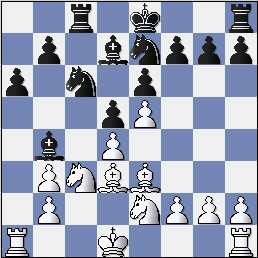
We rejoin the game after move 30, with White’s Bella about to make her bid for glory.
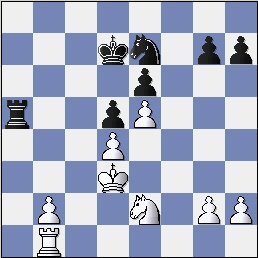
31 b4 Ra3+ 32 Nc3 Ra8 33 b5 Rf8 Trying to gain some activity rather than resort to passive defence. But maybe I should have settled for 33… Rb8. 34 Rb2 White should maybe ignore distractions and press ahead with something like 34 Na4. 34… Kc7 35 Ra2 Nc8 Cutting the rook off from defensive duties on the b file is a somewhat dubious approach. 36 Ra6 Rf2 Once again trying to gain activity, but it’s mostly bluff – 37 Rxe6 Rxg2 38 Nxd5+ Kd7 39 Rc6 Rxh2 must be good for White. 37 Ra2 Rxa2 (=) Here I offered a draw, more in hope than expectation, but my opponent rightly presses on for the full point. 38 Nxa2 Kb6 39 Nc3 Ka5 Things are looking a little more hopeful with the rooks off, but this is still going to be hard to hold. 40 Ne2 A very clever move – I must prevent the knight hitting the e6 pawn. 40… g5 41 h4 h6 42 hxg5 hxg5 43 Nc3 Or 43 Ng1 Kxb5 44 Nh3 Kc6 45 Nxg5 Kd7 46 g4 when the dangerous Bella is replaced by a practically unstoppable Gustav. 43… Na7 43… Nb6 is a good deal stronger – it puts White in something close to zugzwang and probably results in the b pawn dropping very shortly. 44 b6 Bella is seemingly heading for a regal future since 44… Kxb6 allows the dangerous sequence Na4-c5-e6. 44… Nc6 45 b7 Kb6 46 Na4+ Kxb7 Finally I’m left with no choice but to stop Bella at the expense of Eva becoming connected and passed. 47 Nc5+ Kc8 48 Nxe6 g4 49 Ke3 Kd7 50 Nf4 50 Nc5+ would have been pretty terminal. 50… Ne7 51 Ne2 Ng6 52 Nf4 Ne7 53 Ne2 Ng6 54 Kf2 Ke6 55 Ke3 Kf5 (=) Foolishly missing the opportunity to play 55 … Kd7 which would have been a draw by threefold repetition. Instead I give my opponent the chance to have one last stab. 56 g3 Ne7 57 Nf4 Kg5 58 Ne6+ Kf5 59 Nc7 Kg5 60 Ne6+ ½-½
I was more than a little relieved when my opponent agreed to the draw, although the winning method is not entirely clear. Something like 60 Ke2 Nf5 61 Kd3 Nxg3 62 Nxd5 should be winning though.
So on only my second 4NCL appearance, a careless 13th move had led to a marathon 6 hour battle to save the draw. But it was still a great experience – probably the longest game I have ever played. Also an instructional ending, something I would never have had the chance to play in an evening league game with adjudication.
Now, another game, coincidentally from the same match, which shows the kind of entertaining chess which the 4NCL can provide. I’ll attempt to offer some annotations, but if I’m honest, much of what goes on in this game is completely beyond my comprehension. Nonetheless, it is undeniably exciting stuff, so enjoy …
White: Crazy Bandit [Ian Webster]
Black: Wild Warrior [Tyson Mordue]
1 e4 c5 2 Nf3 d6 3 d4 cxd4 4 Nxd4 Nf6 5 Nc3 a6 6 Rg1 Until this move, we had a standard Najdorf Sicilian, but now we are headed down a rather more unconventional path. 6… Nc6 7 g4 The natural follow-up to White’s 6th. 7… h6 I see no obvious reason why Black could not play 7… Nxd4 8 Qxd4 Nxg4, but he is a far stronger player than I… 8 Be3 e6 9 h4 White continues to tread a fine line between launching a dangerous attack and over-extending himself. 9… g6 It seems to me that Black is justifying White’s attack by weakening his kingside pawn structure. 10 f4 Or maybe 10 g5 hxg5 11 hxg5 Nd7. Whether all this pawn pushing is entirely sound is unclear. But undeniably White’s position looks pretty thereatening when observed from the Black side.
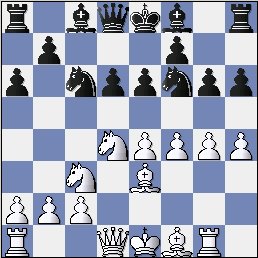
10… h5 11 f5 White completely ignores the threat to his g4 pawn and continues to bash away at the kingside. 11… Nxg4 12 Bg5 Qb6 13 Rxg4 Once again White declines the option of attempting to save a threatened pawn, this time in favour of a daring exchange sacrifice. 13… hxg4 14 Bf6 Nxd4 Why not 14… Rh6 trying to hold the extra material? 15 Bxd4 Qd8 16 fxg6 Not for White the simple 16 Bxh8 Qxh4+ 17 Kd2 Qxh8 reclaiming the exchange at the expense of a second pawn. 16… Qxh4+ 17 Kd2 Bh6+ 18 Kd3 0-0
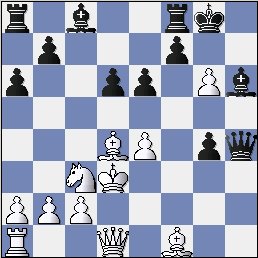
Black must be feeling quite comfortable now – an exchange and a pawn up and a king position which, if not entirely secure, is probably more so than his opponent’s. 19 e5 dxe5 20 Bb6 20 Bxe5 loses to 20… Rd8+, so Black now has yet another extra pawn. 20… Bd7 21 Qe2 Qg3+ 22 Kc4 The White king is having quite an adventurous game. 22… f5 23 Rd1 It really is hard to see how White, whose opponent considerably outgrades him, can rescue even a half point from here. 23… Rfc8+ 24 Kb4
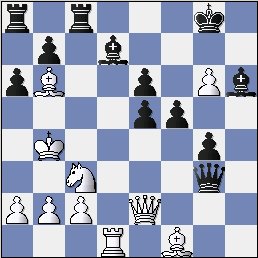
24… Bf8+ 24… a5+ 25 Bxa5 Bf8+ 26 Kb3 Rxa5 27 Rd6 Ba4+ 28 Kb4 must be winning for Black. 25 Kb3 Be8 A curious move. 25… Ba4+ 26 Kxa4 Rxc3 looks more direct. The game move gives White a glimmer of hope. 26 a3 Creating an escape square for the king. 26… Bc5 Black seems to be playing too passively rather than going for the swift kill. 27 Qc4 Rc6? 27… Bxb6 28 Qxe6+ Kg7 29 Qxb6 keeps Black well in front. 28 Bxc5 b6 29 Rd6 Black has miscalculated the tactics, encouraging White that all is not yet lost. The game has turned on its head in a few short moves. 29… Rxd6 30 Bxd6 Bxg6
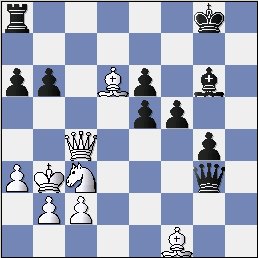
As the dust begins to settle, at least for a while, we find White with a bishop and knight for a rook and three pawns and the game is right in the balance. 31 Qc7 Bf7 Maybe 31… Qf2 holding the b pawn. But White doesn’t seem that interested in trying to mop up pawns. 32 Bc4 b5 33 Bd3 Qe3 34 Bxe5 Finally pawns start falling. 34… g3 35 Qc6 35 Bxg3 loses to 35… e5+ and then 36… Qxg3. 35… Qxe5 I’m not sure Black really needs to give back the exchange – something like 35 .. Re8 looks solid enough. 36 Qxa8+ Kg7 37 Qf3 After 37 Qxa6, White is, astonishingly, slightly better. But White is understandably cautious about the Black g pawn. 37… Qe1 38 Kb4 Bg6 39 Ka5 White’s wandering king is now usefully placed to act as an attacking piece. 39… e5 40 Bxf5 It is now White who is clearly winning. 40… Qf2 41 Qb7+ Kh6 42 Bh3 Once again, perhaps paying undue respect to the g pawn when 42 Bxg6 Kxg6 43 Qxa6+ could have been played. 42… Qxc2
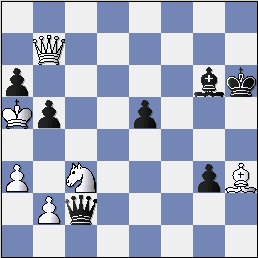
Now it is White who is beginning to let Black back into the game. White has a knight for two pawns and the poistion is unclear. 43 Qe7 Qxb2 44 Qh4+ The alternative was 44 Qb4. 44… Kg7 45 Qxg3 White could probably have a draw by seeking to repeat with 45 Qe7+. 45… Qxa3+ 46 Kb6 Qd6+ 47 Ka5 Qa3+ 48 Kb6 Qd6+ 49 Ka5 And a draw by repetition. ½-½
What an extraordinary game! Both players seemed to be clearly winning at various stages, so I guess ultimately a draw was a fair result.
Let’s conclude with a game which shows that even quality players make disastrous blunders. There is hope for us all if the following White player, a FIDE rated performer, can make a move like 6 Qe4 …
White: Generous Benefactor
Black: Grateful Beneficiary
1 e4 c5 2 Nc3 g6 3 d4 cxd4 4 Qxd4 Nf6 5 e5 Nc6 6 Qe4?? Nxe4 0-1
We all have our off days …